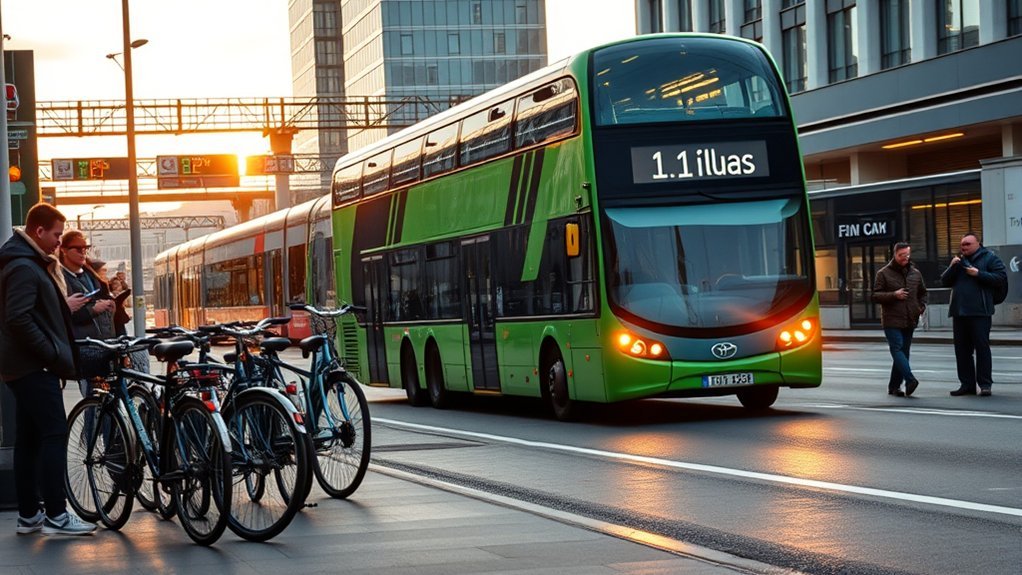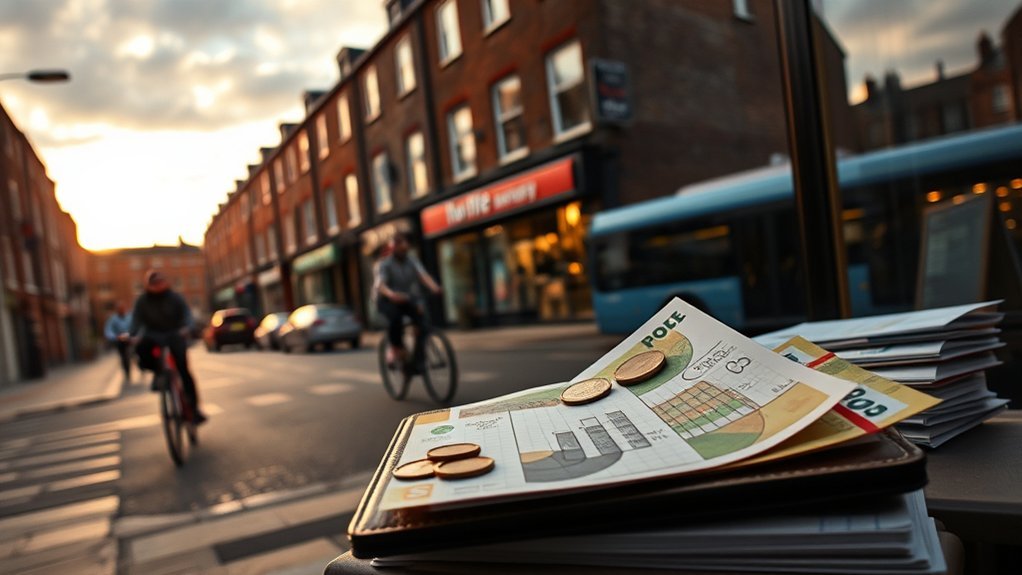You’ll typically need about €2,300–€3,000 a month as a single person and roughly €5,000–€6,000 for a family to live comfortably in Ireland. Housing is your biggest cost, especially in Dublin, with one‑bed rents often €1,300–€1,600. Budget for utilities, groceries, transport, and private health insurance too. If you’re moving from abroad, expect higher initial expenses and plan a buffer. Keep going for practical breakdowns and budgeting tips.
Overview of Living Costs and What to Expect

If you’re planning to live in Ireland, expect monthly expenses that vary a lot depending on location and family size: a single person spends about €2,328 on average, while a family averages €5,272.
You’ll use that average cost of living as a baseline while adjusting for housing costs, transport, and personal habits. Monthly costs often break down into rent or room rates, utilities (€57.9–€114), groceries, and transit.
In Dublin, expect higher rents and room rates around €1,479–€1,635 in central areas, which raises overall living expenses and affects your disposable income.
Transportation costs add another layer: a monthly transit pass runs €111.50–€136.30, while car ownership can cost €830–€1,010 per month.
If you have kids, budget for school-related fees and extras even with public education. Balancing these elements helps you preserve quality of life—choose location and choices that match your priorities and required monthly costs.
Housing: Rent, Buying, and Utilities

Housing will usually be your biggest monthly expense, so it pays to understand rent, buying options, and utility bills before you choose a location.
If you’re living in Dublin, expect higher rental costs: a one-bedroom apartment averages about €1,635/month in the city center and €1,324 outside it. Larger flats jump—three-bedrooms run roughly €2,901 in center areas and €2,351 beyond. Renting a single room (around €1,479) can cut costs if you don’t need a whole flat.
Utilities in Ireland typically range €57.9–€114/month depending on usage and apartment size; factor heating in winter.
Expect monthly utilities around €58–€114, rising in winter when heating pushes costs higher.
If you’re buying, prices and mortgage requirements vary widely by neighborhood, and families often need salaries near €6,000/month to comfortably cover housing and other costs in Dublin.
Weigh commute time, local amenities, and total monthly outlay rather than just headline rent when choosing where to live.
Food, Groceries, and Eating Out

While you’ll find plenty of dining options, your biggest everyday food choices are between cooking at home and eating out—groceries tend to be cheaper for basics like bread (about $1.41–$1.73) and local cheese ($3.44–$4.20).
Local produce and meat can be 13%–62% less expensive than in some U.S. cities. You’ll save if you plan meals and buy local groceries; beef runs about $4.37–$5.34 and home beer is $2.78–$3.40.
Eating out is convenient but pricier: an inexpensive meal is about $16, fast food about $11.99, a mid-range 3-course meal averages $92.68, and dinner for two in Dublin including drinks is typically $70–$86.
Consider the trade-off between time and cost relative to your cost of housing and lifestyle.
- Cook at home: lower weekly food bills.
- Shop local: fresher, cheaper produce and meat.
- Casual dining: budget $11.99–$16 per meal.
- Mid-range nights: plan $70–$92.68 for two.
Transportation and Getting Around

Getting around Ireland means weighing public transport, driving, and active travel to match your needs and budget.
In cities like Dublin a monthly transit pass (about USD$111–136) can be far cheaper than car ownership, which runs roughly USD$830–1,010 per month plus high gas prices.
If you live outside major towns, though, you’ll likely rely on a car, while many urban areas also offer good cycling and walking routes for short trips.
Public Transport Options
In Dublin, you can rely on an integrated network of buses, trams (LUAS) and trains (DART). A monthly transit pass — typically US$111.50–US$136.30 — gives you unlimited rides across services, which is often much cheaper than driving given fuel costs of about US$6.64–US$8.12 per gallon and monthly car expenses of roughly US$830–US$1,010.
Outside major cities, though, public transport is limited and you may need a car for regular mobility.
- Use a monthly transit pass for cost-effective commuting across Dublin’s public transport system.
- Buses, LUAS and DART connect central and suburban neighborhoods efficiently.
- In major cities you’ll find frequent services; plan trips off-peak to avoid crowds.
- Rural areas have sparse service, so check schedules or arrange alternative transport in advance.
Driving and Car Costs
If you live outside Dublin’s frequent bus, LUAS and DART network, you’ll likely rely on a car and should budget accordingly: driving in Ireland can be costly.
Expect total car costs of about USD 830–1,010 monthly, covering insurance, maintenance and fuel. Gas prices run roughly USD 6.64–8.12 per gallon, so fuel will eat a big slice of your transport expenses.
Buying an economy car typically costs between USD 25,500 and USD 31,000 if you prefer ownership over renting.
In Dublin, a monthly transit pass costs USD 111.50–136.30, making public transit a cheaper option for city dwellers.
If you live rurally, factor in higher mileage, parking and occasional repairs when planning your budget.
Cycling and Walking Routes
Because Ireland’s cities and countryside prioritize active travel, you can often choose cycling or walking for short trips and leisure without relying on a car.
The National Cycle Network gives you over 3,000 km of safe cycling links between towns, and Dublin’s investments plus Dublinbikes (about 100 stations and 1,500 bikes) make commuting easier.
Walking routes like the Wild Atlantic Way and Dublin Bay Walk add scenic options.
- Use city center bike lanes and bike-share to cut costs and time.
- Combine cycling with public transport for longer commutes—many routes allow bikes.
- Pick walking routes for short errands; they improve daily mobility and health.
- Plan trips around connected paths to avoid congestion and parking fees.
Healthcare, Education, and Insurance Costs

Now we’ll look at your options for healthcare coverage and what they typically cost, from public eligibility to private plans that most people buy.
You’ll also get a clear view of education expenses—public schooling’s mostly free but has yearly extras, while international students and private tuition can run much higher.
Knowing average insurance premiums and typical school-related costs will help you budget realistically.
Healthcare Coverage Options
When you move to Ireland, you’ll need to decide between relying on public healthcare eligibility and buying private health insurance, which many expats choose—both for faster access to specialists and because private cover is often a visa requirement.
You’ll evaluate healthcare coverage options against your cost of living and budget, knowing the public healthcare system is free for some groups but can mean long waits.
Private insurance is common among expatriates; average annual premiums run around USD $1,000.
Compare plans carefully to match covered services to your needs. Consider:
- Eligibility for public healthcare and potential out-of-pocket costs.
- Typical private insurance annual premium (~USD $1,000).
- Coverage scope for specialists and procedures.
- How insurance affects your overall cost of living.
Education and Tuition Costs
If you’re moving to Ireland with children, you’ll find that public schooling is free but you’ll still need to budget roughly €1,415–€1,730 a year for extras like meals, uniforms and school activities.
While secondary school can run €2,620–€3,204 annually and private or international options cost more. You’ll likely use public education for most needs, but expats often choose private or international schools for specific curricula; international primary tuition in Dublin is about $9,312 a year.
Remember that expats need private medical insurance for residency visas because public healthcare access is limited and can mean long waits.
Expect to pay around €1,000 yearly for health insurance to access private healthcare and shorten treatment delays.
Plan tuition and healthcare together.
Budgeting Tips and Salary Requirements

Looking to keep your household finances steady in Ireland? You’ll want clear budgeting tips tied to realistic salary requirements. A single person’s average monthly expense is about €2,328, so plan a monthly budget around that if you want to manage living costs effectively.
Individuals can live well on roughly €3,000 monthly (€750 weekly); families typically need near €6,000 to cover expenses comfortably and enjoy a comfortable lifestyle. High wages help offset higher prices, so aim for slightly above-average pay if possible.
About €3,000 monthly supports an individual; around €6,000 keeps a family comfortable—aim for slightly above-average pay.
Practical moves reduce pressure on your budget:
- Track fixed vs. variable expenses monthly and set limits for discretionary spending.
- Use local shopping and public transport to cut food, transport, and utility costs.
- Build an emergency fund covering 3–6 months of core expenses.
- Reassess salary requirements annually as living costs and family needs change.
Follow these steps and you’ll keep finances balanced without sacrificing quality of life.
Frequently Asked Questions
Can a US Citizen Live in Ireland?
Yes — you can live in Ireland, but you’ll need to meet visa requirements, secure work permits or residency options, adapt culturally, budget for the housing market and cost of healthcare, and obtain appropriate insurance.
How Much Do You Need to Live Comfortably in Ireland?
Picture a sturdy ship: you’ll need about €2,328 monthly solo or €5,272 for a family. Factor average salary, housing costs, grocery prices, transportation expenses, healthcare fees, and entertainment budgets to steer comfortably ashore.
Is It Cheaper to Live in the USA or Ireland?
Generally, it’s marginally cheaper to live in Ireland overall; your cost comparison shows slightly lower living expenses but higher housing prices in Dublin, mixed food costs, comparable transportation fees, and healthcare expenses differing by system and coverage.
How Much Does It Cost to Move to Ireland From USA?
You’ll spend roughly $3,000–$10,000+ moving to Ireland, covering moving expenses, shipping costs, visa requirements, housing options and settling in; compare costs carefully, plan logistics, and hire help to smooth customs and relocation.
Conclusion
Living in Ireland costs vary, but you can plan smart: expect higher rents in cities, steady utility bills, moderate grocery costs, and reasonable public transport fares; budget for private healthcare or insurance, and factor tuition if you’re studying. Save for deposits, compare neighborhoods, cook more, commute with a Leap card, and track expenses monthly. Aim for a salary that covers essentials, cushions savings, and supports occasional leisure — live well, plan ahead, spend wisely.


